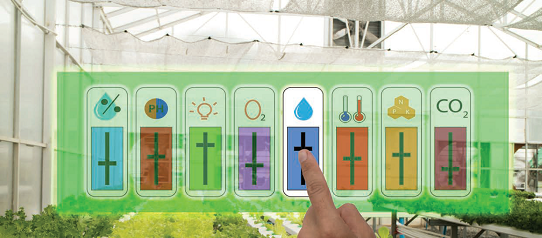Dr. Michael Gaffney, from Teagasc, outlines the key findings from the recent technology in horticulture conference
The recent horticultural technologies seminar hosted by Teagasc on 4 May focused on new
and developing technologies for the protected horticulture sector. Protected horticulture, including mushrooms, now accounts for approximately 70% of the farm gate value of horticulture in Ireland. However, Ireland continues to import extremely significant volumes of produce which could be grown locally. Given the shifting trends in fruit and vegetable consumption towards crops which are grown under protection, it is critical that this sector embraces and is supported in adopting new technologies to increase yield and develop alternative and complementary sources of revenue to reduce the cost of production.
HORTICULTURAL LIGHTING
Light emitting diodes (LEDs) have been identified as the next technological advance in protected growing for many years. The recent proliferation of companies utilising this technology for growing medical marijuana in the United States coupled with an increase in LED production in lower cost economies is reducing the cost of these systems. Also, the availability of independent research tracking energy usage by these systems, compared to alternative systems such as high-pressure sodium (HPS), is giving growers a factual basis to make financial and agronomic comparisons between lighting systems. At the seminar, Dr. Phillip Davis of Stockbridge Technology Centre in the UK highlighted an example which
focused on delivering the required light levels to the crop (in this instance, 200 μmol m-2 s-1 per 10 m2 area) using HPS or a Philips LED top light. While the LED system required twice as many lamps per 10 m2 (1.73 v 3.86), the total power required to deliver the target light levels was 30% lower in the LED system (1041 W v 733 W).
It was also highlighted that not all LEDs are equal. Under the Agriculture and Horticulture Development Board project CP139 they compared the efficacy of five different LED lamps and performance ranged from 1.27 – 2.71 μmol m-2 s-1 which shows the importance of sourcing systems from reputable suppliers, and for growers themselves to understand what light levels are required, and the correct units of measurement.
A constant theme of the presentation was a reminder that more light does result in more growth but also in more cost, and these factors need to be assessed before investment.
Another factor to consider is the ratio of red light to blue light. In general the greater the proportion of blue light in a system, the greater the cost, as blue LEDs are more expensive to produce. The greater the proportion of blue light in a system will compact plant growth, with the opposite occurring with greater far-red light intensity leading to taller plants with
longer internodes. Identifying the correct ratio of light for each individual crop and requirement will be a focus of much research in the coming years.
ON FARM ENERGY CREATION
If lighting, LED or otherwise, is to become more commonplace on Irish nurseries, it is possible that the most cost-effective approach will be to produce the electricity to run those lights ‘on-farm’. But many systems which can produce both heat and electricity tend to require a large financial commitment which may be beyond most small to medium growers. One novel solution was highlighted by Francesco Panzeri of Demetra Limited, an Irish based company specialising in small-scale anaerobic digestion. He highlighted an example of an Italian salad packer who produces 10,200 tonnes per year of waste, which they combine with 2,200 tonnes of a bioenergy crop and animal slurry in their anaerobic digestion unit to produce sufficient gas to provide 300kWh to heat their glasshouses and 250kWe which is sold to the national grid. The resultant digestate is used as an organic fertiliser in the glasshouses. This was a good example of a ‘circular system’, but again the volume and scale demonstrated would only apply to relatively few Irish nurseries. However, their concept, ADbag, utilises an earth bank system to create the reaction chamber where the gas is produced and is approximately 30% cheaper than concrete constructions. This form of construction allows them to build smaller AD systems, either singularly or in pods. The gas is then used to power a combined heat and power plant (CHP) which produces heat, electricity, and CO2. Given a recent Sustainable Energy Authority of Ireland report highlighting that Ireland produces enough animal slurries and food wastes to potentially sustain 900 AD plants of varying size and scale and given the unique ability of horticulture to utilise all three products from the carbon dioxide, heat, and power(CHP), creating and supporting scenarios where AD and horticulture are linked makes both environmental and financial sense.
GOVERNMENT INCENTIVE
A new energy project is a significant investment for any nursery, with the future projections of fossil fuel versus biomass an active consideration when deciding on heating systems, as well as the financial realities of the capital cost on any investment. Barry Caslin of Teagasc updated the conference on the recent consultation process around the proposal for a renewable heat incentive. While the final details of how the scheme will operate and what the rate of support will be have yet to be finalised, it is likely that it will support technologies such as anaerobic digestion CHP and boiler, biomass CHP and boiler and other technologies applicable to the horticultural sector. While the capital costs of systems such as these will be higher than those utilising gas and oil, the rate of support may make an investment in these renewable technologies more attractive to growers.
GLASSHOUSE STRUCTURES
Since the 1970s, glasshouse heights have increased at a rate of about 1m per decade. Currently, new houses in Ireland are being built to a gutter height of 5.5m, with houses over 6m high becoming common in Europe. This increase in height increases the volume of air within the house, giving more control over the environment. The increase in height has also been to accommodate changes to growing practice such as screens, lights and increased mechanisation and robotics. It is questionable how much higher glasshouses need to be, although houses as high as 8m are currently under construction in Europe. With glasshouse construction quotations regularly exceeding €55 per m2 for a 5.5m high glasshouse in Ireland, economic realities rather than technology may limit any further height increases. Recent developments in glass also have the potential to increase yield, with the use of diffuse glass which scatters light when it passes through the pane. This scattering of light increases the haze and can increase yield, but it does lower light transmission. Experiments in Holland indicated an 8-10% increase in yield in tomatoes, 4-10% increase in yield in cucumbers and 25% bigger potted plants while simultaneously reducing production time from 22 to 16 weeks. While this sounds extremely promising the cost of retrofitting an existing structure to diffuse glass is very significant and given the fact that light levels in Ireland can be low, even in the summer months, the reduction in light transmission caused by the diffuse glass may ultimately negate any benefits.
PLANT BREEDING
The future direction of food production is towards a more sustainable model, utilising new technologies to increase yields and quality. Dr. Ewen Mullins of the crop science department in Teagasc gave an update on the recent advancements in genome editing which allow plant breeders to upgrade already well-adapted varieties by utilising proteins to edit a plant’s genome. This new technique has the potential to significantly decrease the time to produce new varieties and can allow breeders to select for specific traits to enable plants to become more resistant to diseases, physiological stress and also to potentially enhance the nutritional quality of the produce. These techniques, the best known of which is referred to as CRISPR-CAS, have already been used extensively across a range of horticultural crops to select for desirable traits in a research setting, but a recent decision by the US government that an edited mushroom can be cultivated and sold without passing through the US Department of Agriculture’s (USDA) regulatory process makes it the first CRISPR-edited organism to receive approval. It is likely that other edited varieties will soon become available in the US. The EU is yet to make a decision as to whether they fall outside of EU legislation, even though the regulatory agencies of Ireland, England, Germany, Holland, and Sweden have stated that they do, which would allow them to be sold within the EU.
Given the technological advances in protected growing, it is possible for Ireland to produce much of its salad and soft fruit requirements, a large proportion of which are currently imported. These crops require large amounts of CO2 and can be combined with renewable technologies, such as anaerobic digestion to create extremely sustainable crop production systems. Intensive horticulture such as this creates employment with most modern glasshouses creating five to 15 direct jobs per hectare depending on the crop. The protected crops sector has traditionally been extremely quick to adopt new technologies and practices. But the cost of new technologies is extremely high and increasing, for example, a modern tomato growing house will cost approximately 0.5m per Ha for the structure alone. All indications are that the importance of this sector will increase as consumers continue to favour salad and fruit crops. Having said that, with strong completion from low cost imported produce it is critical that the sector continues to adopt new technologies and is supported to do so. It could be that linking horticultural production with sustainable energy creation may be the key to unlocking the significant potential in this sector.
All presentations from the Teagasc Horticultural Technologies seminar are available to download at https://www.teagasc.ie/publications/2017/teagasc-horticultural-technologies-seminar.php ✽
 Dr. MICHAEL GAFFNEY is a senior research officer, specialising in entomology and horticulture in the Horticulture Development Department at Teagasc and is also an adjunct lecturer in crop protection at the School of Agriculture and Food Science at University College Dublin. He leads a diverse research group focusing on IPM, crop protection, and crop quality. He can be contacted at Michael.Gaffney@Teagasc.ie
Dr. MICHAEL GAFFNEY is a senior research officer, specialising in entomology and horticulture in the Horticulture Development Department at Teagasc and is also an adjunct lecturer in crop protection at the School of Agriculture and Food Science at University College Dublin. He leads a diverse research group focusing on IPM, crop protection, and crop quality. He can be contacted at Michael.Gaffney@Teagasc.ie






